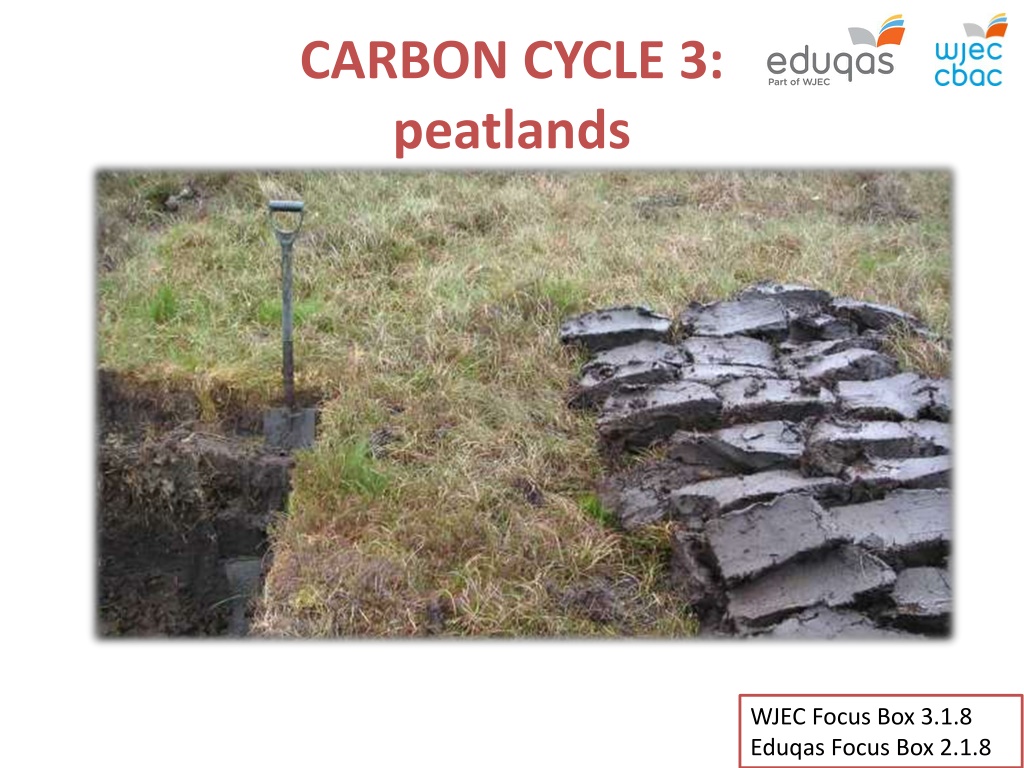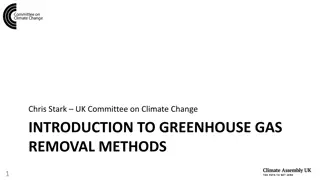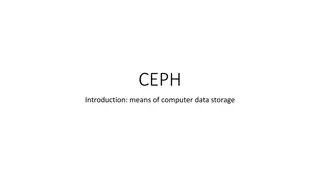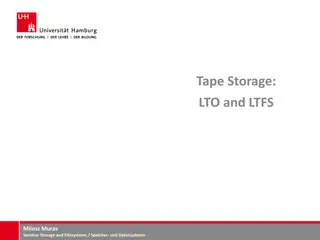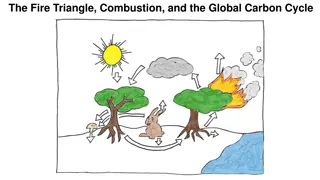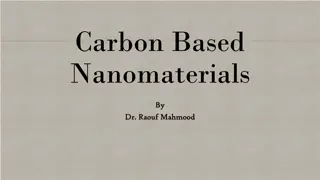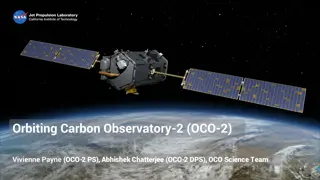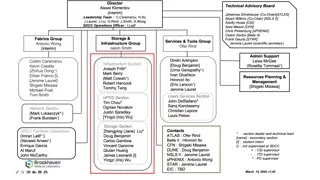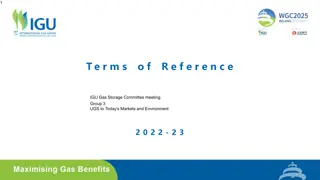Understanding Peatlands and Carbon Storage in the Carbon Cycle
Peatlands are vital landscapes where peat accumulates, storing large amounts of carbon. Learn about peat formation, anaerobic conditions, different types of peatlands, and the significant role peatlands play in carbon storage globally. Explore the link between water cycle and peat formation, emphasizing the crucial role of undisturbed peatlands in carbon sequestration and their environmental importance.
Uploaded on Sep 27, 2024 | 0 Views
Download Presentation

Please find below an Image/Link to download the presentation.
The content on the website is provided AS IS for your information and personal use only. It may not be sold, licensed, or shared on other websites without obtaining consent from the author. Download presentation by click this link. If you encounter any issues during the download, it is possible that the publisher has removed the file from their server.
E N D
Presentation Transcript
CARBON CYCLE 3: peatlands WJEC Focus Box 3.1.8 Eduqas Focus Box 2.1.8
Carbon Cycle 3 Peat formation Peat is a thick layer of black or dark brown sticky and wet soil material containing very high levels of partially decomposed vegetation (mosses, rushes, sedges and bracken) The carbon-rich plant remains are slowly compressed as more material is added each year until; in the UK, peat is sometimes 2-4 metres deep Class discussion Have you ever visited a peatland environment? Have you heard of peat being used for gardening or food production?
Carbon Cycle 3 Anaerobic conditions Decomposition is prevented by waterlogging, which creates oxygen-deficient anaerobic conditions This limits microbial decomposition of organic matter, especially in cooler upland sites Occasionally, recognisable animal remains from thousands of years ago are found preserved in peat. In 1984, a 2,000-year-old well-preserved human body was found buried in Wilmslow, Cheshire (the media named him Pete Marsh ) Class research task Find out more about Pete Marsh https://www.youtube.com/watch?v=GN6nJGQpcSc
Peatlands are landscapes where layers of peat have accumulated. Globally, peatlands cover many hundreds of square kilometres, with thicknesses of 10 metres or more Carbon Cycle 3 Differing types of peat Fen peatlands form where groundwater meets the surface at springs or the edge of open water Blanket peatlands occur on flat hill tops where rainfall is high Raised bogs occur in valley bottoms where soils are saturated, due to the frequent arrival of throughflow and overland flow from the slopes above Class activity Think about topic linkages between the water cycle and the formation of peat (and carbon storage)
Carbon Cycle 3 Carbon storage in peat There is a net accumulation of carbon over time in undisturbed peatland: the rate at which atmospheric carbon is fixed in new peatland plants by photosynthesis greatly exceeds the loss of carbon through decomposition Despite only covering 5 per cent of the land area of Wales, deep peatland soils represent 30 per cent of the country s total soil carbon storage Globally, peatlands store 550 billion tonnes of carbon Class activity Research peat resources in Wales: https://www.forestry.gov.uk/fr/INFD-8Z7BSH or
Carbon Cycle 3 Peat extraction: carbon storage loss Only 20 per cent of UK peatlands are not degraded and remain in a pristine state Rates of carbon sequestration in degraded peatlands are reduced; they may even become sources of carbon emissions instead Peat has been dried and burned traditionally in many rural areas as a fuel source Peat is extracted for use in garden centres, and food and drink industries (smoked food) Class activity Find out how peat is used in whisky production: https://www.whisky.com/information/knowledge/tasting/flavour/peat- and-its-significance-in-whisky.html
Carbon Cycle 3 Peat extraction: carbon storage loss This historical image shows peat extraction in Somerset in 1905 Class activity Think about topic linkages between studies of peat extraction and Changing Places (unit/component 1)
Carbon Cycle 3 Peat drainage and land use change Drainage Around one quarter of English peatland is under cultivation; from 1640 onwards the East Anglian fens, were drained for farming. This produced good agricultural land but degraded the peat Pollution Peatlands in Yorkshire have been subjected to decades of pollution from Manchester and Sheffield, harming peat-forming plant species Burning Large areas of peatlands throughout the UK are affected by moorland burning. This is a widespread land management practice in upland areas for the management of game, such as grouse Forestry Peatlands drained by the Forest Commission will begin to emit CO2 and lose some soil carbon via leaching and erosion, but this may be offset over time by the CO2 captured by the growing trees Class activity Research these activities further and discuss the relative severity of their impacts on carbon storage
Carbon Cycle 3 Carbon storage loss The table shows how different human activities affect carbon capture and release in peat environments Land use (in peatland areas) Net carbon flux (tonnes of CO2 per hectare per year) 22.4 net loss 8.7 net loss 2.6 net loss 2.5 net loss 0.1 net loss 0.1 net loss 4.1 net storage Cultivated & temporary grass Improved grassland Rotationally burnt Afforested Bare peat Overgrazed Undamaged Class activity Discuss reasons for the changes shown in the table above
Carbon Cycle 3 Peatland restoration (1) Peatland restoration could help the UK meet reduction targets for long-term greenhouse gas emissions - by offsetting emissions produced by economic activity Restoration efforts usually include: the re-establishment of a plant cover dominated by peatland species including sphagnum mosses the re-wetting of drained peatlands by raising and stabilizing the local water table Class activity Research examples of peatland restoration in England or Wales: http://www.wildlifetrusts.org/peatlands
Carbon Cycle 3 Peatland restoration Southern Pennines peatlands in Yorkshire were extensively drained and eroded in the past Recently, erosional gullies have been blocked with stone dams to raise the water table and restore anaerobic conditions New seeds and fertilizer are scattered using helicopters Photograph shows gullies which have been blocked deliberately in order to promote water retention
Carbon Cycle 3 Plenary Peat formation takes thousands of years. Peatlands are located in poorly-drained sites throughout the UK Undisturbed peatlands serve as a carbon sink but land-use changes and peat cutting have led to the degradation of the majority of UK peatlands: most no longer function effectively as carbon stores and have become carbon sources instead Peatland restoration in the UK and elsewhere can be a valuable way of reducing net carbon emissions Management strategies for peatland restoration include re-wetting and the reintroduction of wetland species
